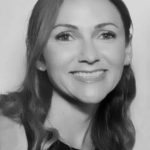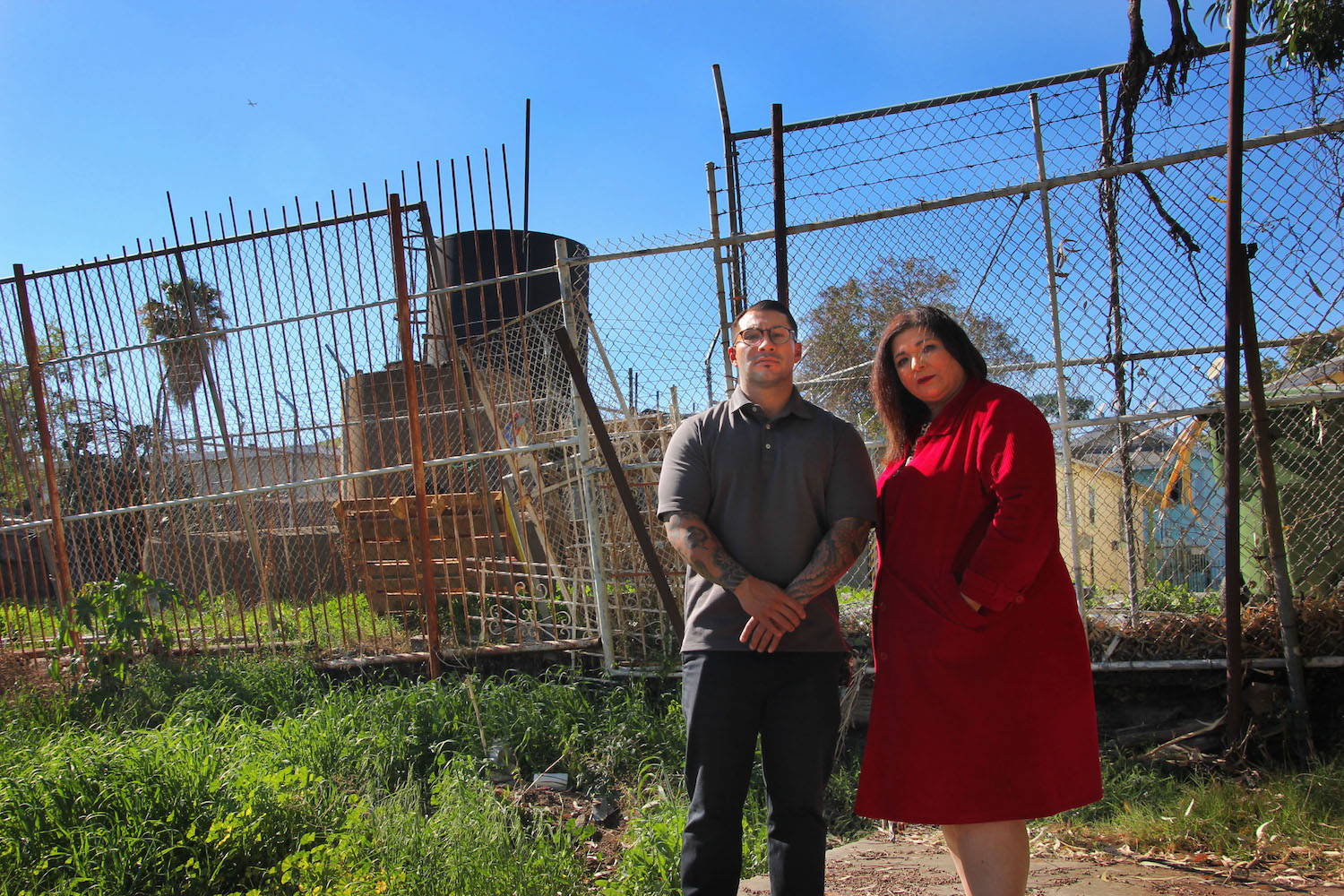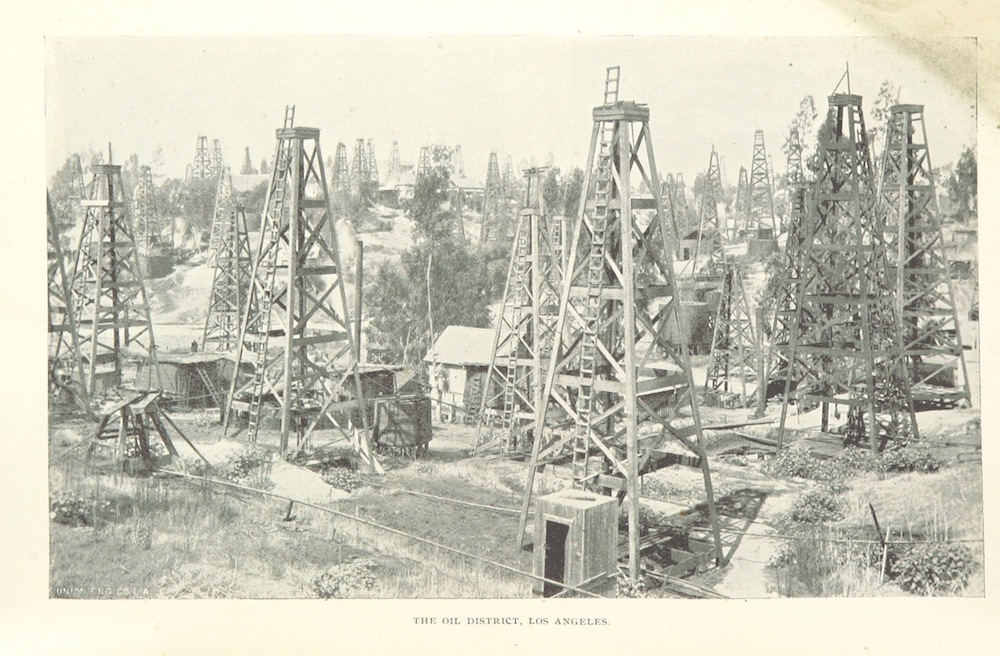On November 28, 2015, Roger Majano, plagued by a noxious smell overwhelming his Los Angeles neighborhood, heaved a jackhammer onto the walkway in front of his property at 323 Firmin Street. It was the dead of night, but Majano had run out of patience trying to get to the bottom of the sickening and persistent smell.
What he found, two days later, would eventually confirm his fears and frustrations surrounding an environmental and public health risk haunting the City of Angels. Under his property, Majano had discovered an ancient oil well, leaking potentially toxic gases.
Firmin Street sits directly atop the Los Angeles City Oil Field, where, during the first half of the twentieth century, thousands of active oil wells dotted the four-mile stretch from Downtown to Hollywood. This oil field contains masses of explosive and toxic fumes, which experts link to long-term health problems, including cancer and severe respiratory illnesses. The old wells are conduits for these dangerous fumes and may be quietly affecting tens of thousands of Los Angeles residents in this densely populated area — including in Majano’s Vista Hermosa neighborhood.
By 1950, after Los Angeles’ oil boom slowed, oil well owners began unsystematically deserting the no longer productive wells — filling them with items including telephone poles, old rags, and garbage.
Los Angeles Oil Field circa 1895. Credit: The Mechanical Curator collection, British Library, no known copyright restrictions
Today, modest bungalow homes, apartment buildings, and schools have largely replaced the thousands of oil derricks that once towered over the area. Post-World War II, many of the oil wells were shallowly cemented over, and according to residents, most of the houses and buildings were moved to, rather than built directly on, the neighborhood. But the antique oil wells remain, most hidden underground. And according to maps, one well was buried directly under Majano’s property.
Seeking Resolution
Armed with this new information but six months before digging up his front yard, Majano reached out to authorities, including the California Department of Oil, Gas, and Geothermal Resources (DOGGR), a state agency that regulates and oversees oil activity. In an April 14, 2015 email to DOGGR, Majano said he believed the persistent smell was coming from abandoned wells in the area and that he was concerned for the health of the neighborhood.
The following day, DOGGR’s William Flores told Majano that he had received another complaint from a neighbor, Rosalinda Morales, and that the division would follow up with him soon.
Morales, a 60-year resident of Firmin Street, says the pervasive smell of “rotten eggs” has been a fixture in her neighborhood for as long as she can remember. And while the odors were a nuisance, she says the effects of them were far more threatening.
Roger Majano and Rosalinda Morales with downtown Los Angeles in the background. Credit: © Marissa Pianko
“I always had breathing issues, since I was an infant. I was incredibly susceptible to respiratory illnesses and was finally diagnosed with asthma when I was 12,” Morales told DeSmog.
After Morales moved to South Pasadena following her college graduation, her asthma symptoms all but disappeared. But when her father died of a heart attack in 1992, she moved back to Firmin Street to live with her mother. Her asthma symptoms returned — worse than ever — and she reports visiting the emergency room about twice a year due to severe asthma attacks.
According to Morales, the smell became progressively worse in 2011. “It was horrible. I was nauseous,” she said. “Most of the people in the neighborhood — it was rare to find people that didn’t have breathing difficulties, like asthma.” Morales and her neighbors called a number of agencies, including the Los Angeles Fire Department (LAFD) and DOGGR, as well as the utility Southern California Gas. “They would show up in hazmat suits,” said Morales. “They would poke around and say, ‘Oh yeah, we’ll report it.’”
That same year, Morales’ mother, who had no family history of cancer, was diagnosed with breast cancer and passed away. Within four months, two other residents who had lived most of their adult lives on Firmin Street died as well — one of a rare cancer and the other of an aneurism.
The residents of Vista Hermosa would later discover that the foul odors they were smelling were indeed linked to leakages from the abandoned wells. Specifically, the “rotten egg” smell is associated with hydrogen sulfide, a highly toxic gas common in deteriorating oil wells. Hydrogen sulfide and hydrocarbons from oil wells present serious short-term and long-term health effects.
“As soon as you start smelling hydrogen sulfide, you should run for your life. It’s a deadly gas,” said petroleum geologist Dr. George Chilingar. “Hydrogen sulfide, even in small quantities, can be toxic to human health.”
Another major issue with deteriorating oil wells is the release of methane, an odorless, yet highly explosive gas that’s the main ingredient in natural gas. Several explosions are associated with old oil wells in Los Angeles. “If you build a house over an abandoned well, it’s like building a house over a volcano,” said Chilingar. “Eventually, it will come out.”
The Battle to Cap the Wells
Unbeknownst to Morales, all of the “poking around” in 2011 initiated concern at DOGGR about an orphaned well across the street from Majano’s property on Firmin Street. The well, known by the agency as “Patel 1,” was deserted by its owner over 100 years earlier.
Old oil wells should undergo specific processes at the end of their productive lives. “When a well is not capable of producing, it must be shut in properly and, eventually, plugged and abandoned (permanently sealed). Otherwise, it will deteriorate and corrode, potentially becoming an environmental and safety concern,” according to the California Department of Conservation (DOC), which oversees DOGGR.
According to DOGGR’s 2018 records, 854 wells currently sit idle on the four-mile stretch of the Los Angeles City Oil Field. Of those, 16 lie under the properties on Firmin Street.
Los Angeles City Oil Field well map Credit: DOGGR Well Finder
In 2012 and again in 2014, after several complaints and inspections, DOGGR attempted to find a contractor to permanently seal Patel 1, but noted in a later email “the bid amounts exceeded the available budget.”
Still, the smell became progressively worse, and in September 2014, DOGGR visited the Patel 1 site after receiving another complaint from a resident. The agency reported a “notable ‘rotten egg’ smell…[that] strongly suggests fugitive emission of hydrogen sulfide (H2S).”
The agency returned to inspect the property after yet another complaint in April 2015, but again made note of no other action.
In the meantime, Roger Majano was searching for a resolution to the pervasive smell on his property. In response to Majano’s requests for help, DOGGR, often joined by representatives of local and regional authorities, visited Majano’s property several times in October of 2015. At each inspection they noted striking issues, including yellow discoloration and corrosion of the cement in the front yard, an “overwhelming” odor of “rotten egg” and alarming readings of methane and hydrogen sulfide.
Stained and corroded cement in the front yard of Roger Majano’s property on Firmin Street. Credit: Roger Majano
At one visit, a South Coast Air Quality Management District (AQMD) official used a hydrocarbon sniffer to measure a high of 140,000 parts per million (ppm) of methane, which Timothy O’Connor of the Environmental Defense Fund notes is an extremely dangerous reading. O’Connor says that regional air quality control measures dictate that, “when there is a release of methane at greater than 10,000 ppm, it must be repaired.” Levels over that amount present an explosive and environmental hazard.
Further, the official recorded concentrations up to 34 ppm of hydrogen sulfide from the cracks in the concrete on Majano’s property. Such a level is well beyond what the U.S. Department of Labor (DOL) deems as safe. DOL indicates that levels of as little as 2 ppm of hydrogen sulfide can cause nausea, headaches, tearing, loss of sleep, and airway problems. The ceiling exposure limit for workers is 10 ppm for 10 min. At 100 ppm, it is “immediately dangerous to life and health.”
DOGGR officials acknowledged that Majano was concerned about the possible health effects of these emissions for the residents. “Here’s a well that’s obviously emitting hazardous gasses and you’re letting it go until you can try to figure out a solution? They should have capped it immediately,” Majano told DeSmog.
On October 27, an air quality official took another hydrogen sulfide reading. According to an AQMD report, the hydrogen sulfide reached a high of 100 ppm — the level “immediately dangerous to life and health.” After AQMD’s inspection, and the high readings of hydrogen sulfide, Majano felt certain that DOGGR would finally properly abandon the well under his property.
Much to Majano’s dismay, DOGGR deferred responsibility for the situation. In an October 27 memo, Raul Lima of DOGGR wrote that the agency and an LA Fire Department official “made clear to Majano that we do not know if the source of the odor is from an abandoned well because we do not have evidence to support the existence of a well on the property.” However, DOGGR maps, dating back to 1950, show an oil well on Majano’s property.
Los Angeles City Oil Field Well Map dated 1950. The black dot on lot 11 of Firmin St, just to the lower right of center, indicates the well on Majano’s property. Credit: DOGGR Public Records Rogalske 10 File
Lima continued, “We made it clear to him that the Division is not responsible for locating the well, nor is the Division responsible for mitigating any environmental concerns with the odors.”
Overwhelmingly frustrated, Majano expressed to DOGGR that if the agency couldn’t do anything, he would have to dig it up himself. “At one point I was like if I find an oil well, ‘is that mine,’ and they said, ‘no,’ and I said, ‘why not?’ And they said, ‘you don’t own the rights to it.’” He added, “It was a very big battle. I was taking on this by myself — no one else was helping me. It was, ‘I gotta do what I have to do’ or else I’m going to bury myself in this property.”
Lima advised Majano against looking for the well, because of the potential dangers of excavating a well, including explosions and exposure to toxic emissions. According to California Public Resources Codes 3260-3266, an orphan idle well is the responsibility of the state, and therefore, if the well is determined to be a threat to life, health, or human resources, DOGGR is responsible for remediating it. However, DOGGR representatives would neither acknowledge the presence of an oil well nor that the rotten egg odor was a result of a well.
Nevertheless, Majano took matters into his own hands in November 2015, ultimately unearthing a 2-by-4-foot concrete slab beneath his walkway. When he lifted the slab, visible fumes rose to the surface from a hole, lined in redwood. The concrete surrounding the well was severely corroded and stained yellow. But it was the smell that nearly knocked him off his feet. He covered it back up, and feeling a sense of vindication, called DOGGR to inspect it.
Lima returned to the site on December 2, and finally confirmed to Majano that the hole in his front yard was indeed an old oil well and the source of the foul odor. The oil well was named Rogalske 10, one of 25 such wells dug a century earlier.
At the same time this was unfolding on Firmin Street, 30 miles across town in the upscale neighborhood of Porter Ranch, the biggest methane leak in U.S. history was occurring at the Aliso Canyon natural gas storage facility. The leak released 100,000 tons of gas into the atmosphere over four months. DOGGR had received intense media scrutiny over the issue, which Morales and Majano believe served as motivation to finally seal the leaking Patel 1 and Rogalske 10 wells.
Capping a Long Process
On July 15, 2016, over five years after residents of Firmin Street began raising the alarms, contractors started work to cap the two leaking orphaned wells. But the process would still have some challenges ahead.
Contractors capping the Rogalske 10 oil well on Roger Majano’s property in July 2016. Credit: Roger Majano
When they opened up the wells and began working, “the smell was worse than ever,” Morales said. Residents began reporting a range of health complaints consistent with exposure to petroleum fumes, but according to Morales, DOGGR relocated only one residence before the capping process began — the home at the Patel 1 site.
Two weeks into construction, the Los Angeles Department of Public Health (DPH) temporarily shut down the work site while it examined the complaints and recommended safety measures, including relocating affected residents during the capping process. DOGGR did not relocate any other residents, but DPH allowed work to continue after other safety measures were addressed. The DPH report noted that acute conditions persisted until the project was completed.
Rosalinda Morales (center) with the contractors capping an orphan well on Firmin Street. Credit: Courtesy of Rosalinda Morales
Though DPH noted a lack of studies on the long-term health impacts of living alongside abandoned wells, they asserted that the close proximity of the wells to the residents could have unavoidable health and safety impacts.
The Future of Vista Hermosa Residents
While two of its idle wells have now been properly sealed, 16 other inadequately shut down oil wells remain buried underneath the barely 750 foot-long Firmin Street, with hundreds more in the vicinity.
All of these old wells mean “eventual trouble,” according to the petroleum geologist Chilingar. “We need to find the technology to locate these abandoned wells, because some of them are unknown to us — we don’t know where they are. Pressure builds up and it’s only a matter of time before this happens again.”
According to a recent Los Angeles Times/Center for Public Integrity investigation, the problem extends far beyond the Los Angeles City Oil Field. There are 35,000 idle oil wells across the state of California, with many reports of serious health and environmental implications. Further, the investigation found, taxpayers may be left with the bill to cap these wells.
The density of homes and the location of the buried wells on the Los Angeles City Oil Field means proper capping comes at a huge cost. DOGGR spent approximately $1.4 million on the 2016 capping of just two wells, Patel 1 and Rogalske 10, on Firmin Street. DOGGR has a temporary statewide budget of $3 million per year for capping and abandoning orphan wells. The annual budget decreases back to $1 million in 2022. At this rate, the state could take hundreds of years to properly cap the wells in this four-mile stretch of Los Angeles.
In October 2019, California Governor Gavin Newsom approved Assembly Bill 1057, which dramatically changed the funding and purpose of DOGGR. As a result, DOGGR became the California Geologic Energy Management Division (CalGEM) and refocused its mission toward environmental protection.
CalGEM has not replied to a list of questions about the agency’s handling of the Patel 1 and Rogalske 10 wells.
The following month, Governor Newsom signed another bill intended to protect residents and the environment from abandoned oil wells. Assembly Bill 1328 dictates that the state monitor emissions from oil wells (both idle and active) to ensure safety of local residents. According to the bill, results of air monitoring results will be posted on or before January 1, 2022.
A spokesperson for the California Independent Petroleum Association (CIPA), a state-based oil and gas trade group, worries that additional regulations will actually increase California’s carbon footprint. Specifically, the group claims that the recently passed AB 1057 — which requires active oil well operators to post additional bonds to cover the cost of capping at the end of a well’s productive life — will force smaller operators out of the oil industry. CIPA believes this will lead the state to import more oil from the Middle East and further overwhelm busy California ports. Though CIPA originally opposed AB 1328, it ultimately removed its opposition.
Rosalinda Morales (far right) and Roger Majano (third from right), posing with Los Angeles Mayor Eric Garcetti (center) and other officials. Credit: Courtesy of Rosalinda Morales
While some Vista Hermosa residents find this new legislation promising, they say that air monitoring will only do so much. Today, CalGEM caps orphan wells as issues arise, but considering the history, neighbors want these wells capped before they become problematic.
Since the capping of the oil well on his property, Roger Majano has finally rented out his house on Firmin Street, doing his best to keep the property immaculate and his tenants happy.
Morales, meanwhile, is still coping with the legacy of oil drilling in the area. The night of December 18, 2019, she witnessed crude oil from a century-old well flowing down two city blocks and into a storm drain. A mixture of oil and water filled a neighboring apartment. Given these incidents and the hundreds of remaining idle wells, Morales continues to meet with city and county officials, pushing for better health and safety protections for Vista Hermosa residents.
While optimistic about newly passed legislation, Morales knows the path to real resolution is long. More than that, she is convinced that some damage has already been done. “Who knows what will happen to me?” she said, acknowledging her decades of exposure. “I hope not to die of cancer — that seems to be what happens to people in this area.”
Main image: Roger Majano and Rosalinda Morales next to “Patel 2,” an above-ground idle oil well at the end of Firmin Street in Los Angeles. Credit: © Marissa Pianko
Subscribe to our newsletter
Stay up to date with DeSmog news and alerts
















